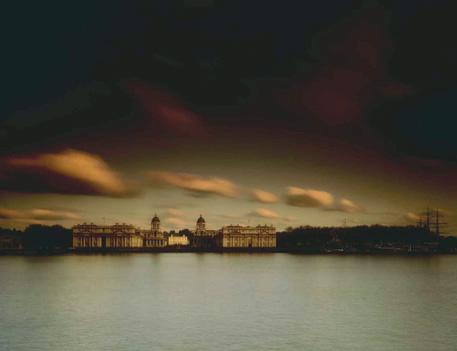
Photograph copyright ©1999 - 2018 Denis Waugh.
External Links
GREENWICH
Greenwich was a royal residence probably since the time of Edward I in 1300. Certainly, there was a Tudor palace here: `Placentia', or the `Pleasant Place' built by Henry VII. Placentia was a conglomeration of domestic and administrative buildings spreading out haphazardly along this stretch of the Thames where the elegant arrangement of Wren buildings now stands and it features in the background of numerous seventeenth-century paintings in the National Maritime Museum.
Henry VIII was born in Placentia, as were his daughters Mary and Elizabeth, and the ancient hollow oak tree where Henry courted Anne Boleyn and where little Elizabeth played finally blew down only during the gales of the early 1990s. Henry ruled from here for twenty years and his tournament ground lies below the handsome building housing the administration wing of the museum.
At a window of Placentia Henry's son, the sickly and sad young king, Edward VI was displayed, rouged and coroneted, by his `protectors' the Duke of Somerset and the ambitious John Dudley, Duke of Northumberland. The charade was to persuade the local populace that the king ruled and all was well. But all was not well because Edward was dying of consumption, although there are rumours that it was not consumption that finally killed him.
Having diverted the succession away from his Catholic sister Mary to his cousin Lady Jane Grey, married at fifteen to Dudley's son, Edward was allowed (or quite possibly helped) to die at the age of sixteen. It is rumoured that a local boy bearing a physical resemblance to him was murdered to provide a more attractive corpse - and also to allay suspicions as to the cause of his death, which were, not without foundation, pretty grim. If this is the case, then Edward's body is perhaps buried somewhere under these smoothly inscrutable lawns.
After the Restoration it was Charles II's intention to construct a new palace at Greenwich, but although the observatory was completed, building on the palace was halted in 1669 when funds ran out with only one wing completed. It was not until 1694 that the other was built, on the orders of Queen Mary, who envisaged a naval hospital to match Charles II's hospital in Chelsea for soldiers. Mary recalled Sir Christopher Wren to the project, who offered his services free and appointed Nicholas Hawksmoor his assistant.
The compact, Palladian-style house in the midst of Wren's elegant rectangle is the Queen's House, begun in 1616 by Inigo Jones for Anne of Denmark, James I's consort. Anne died in 1619 and when the house was finally completed in 1635 her daughter-in-law, Henrietta Maria, moved in. When Mary made her plans for the hospital in 1694 she was reluctant to have the house obscured from the river, which is why Wren's building encloses it so protectively.
But Mary, sadly, died that very year. It was sad. Mary was thrust centre stage as a revolutionary, landing with her husband and first cousin, William of Orange, when leading clerics and landowners asked him to invade. Her father, James II and his second wife the Catholic Mary of Modena were forced to flee to France with their baby, James Stuart (the `Old Pretender'.) But Mary loved her father and everyone loved Mary. During her short reign she did a lot to atone for the previous excess of the Stuart courts and when she died Purcell wrote his Ode on the Death of Queen Mary for her.
Mary's brother-in-law, Prince George of Denmark, bought the Queen's House in 1708, intending to give it to the Naval Hospital, but George, too, died before his plans were realized. Not a lot went right for George. He didn't have a sparkling personality and Charles II said of him: `I've tried him drunk and I've tried him sober and there's nothing to the man.' But Queen Anne, Mary's younger sister, loved him and bore him seventeen children, all of whom died in infancy.
Which is why the succession went to the Protestant Elector of Hanover, George I, who landed in Greenwich in 1714 and why the first ever Hanoverian reception was held here in the Queen's House.
Text copyright ©1999 - 2018 Priscilla Waugh.